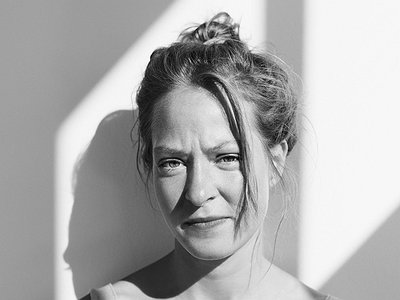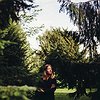Part 1
Name: Pauline Hogstrand
Nationality: Swedish
Occupation: sound artist / violist / producer
Current Release: The Enterer on No Technique and Forlaget Kornmod
Recommendations: I am greatly inspired by and enjoy reading themes of abstract existential philosophy, and I would especially want recommend All the Kings Horses by Emelie Cajsdotters. Her newest release Det Sjunger I Gräset will be out in early 2021 in Swedish, hopefully soon also translated to English. Reading her books has made me use my senses to look at the world in a different way, with much more magic than the grown-up eye has learned to see / In a similar theme, Spell of the Sensuous by David Abram explores perception and language of nature. A declaration that we can access the most real and raw form of magic in an unsuperstitious world grounded in science, if we are willing to soar beyond into a non-materialist mode of perception.
Visit Pauline’s website paulinehogstrand.com for more info about her music, collaborations and events.
When did you start writing/producing music - and what or who were your early passions and influences? What is it about music and/or sound that drew you to it?
Before I took on training as a classical viola player, I had quite an eclectic relationship to music where my role was more of a multitasker than a specialised instrumentalist. I didn’t grow up in family of musicians, but my parents sang in choir and they loved music. My mom used to take me and my sister to symphony orchestra concerts and I specifically remember how I thought that the most beautiful moment of the whole performance was when the musicians would tune their instruments. I simply loved the open sound of strings and the slight chaotic atmosphere where everyone played at the same time in an unorganised manner, listening to the clashes between all the different tuned and open ringing pitches.
At my home growing up, we never really had much money. Some periods we lived very poorly. But somehow my mom would always make sure that there were all kinds of instruments around. Guitars, exotic flutes, percussive, a piano and so on. Money would not be the reason to stop the musical experiments. She didn’t try to lead me in any direction, but simply just made sure that the possibilities were there. It was a playground. At that time, I was writing songs with the guitar and piano, making mixtapes with underground music, playing with samples and field recordings.
Classical music, and especially instrumental music, has always fascinated me with its long forms, continuous renewal, and broad variety of timbre. Musical gestures, similar to our body language, very often creating feelings out of this world and euphoric. However, it was after finishing the Royal Danish Academy of Music that I, by chance, stumbled on a course in electroacoustic composition at Malmö Academy of Music, I started focusing on composition. The creative process reminded me of the value of playfulness and my own space with music that I had growing up, which I discovered I had been missing for a long time.
For most artists, originality is first preceded by a phase of learning and, often, emulating others. How would you describe your own development as an artist and the transition towards your own voice? What is the relationship between copying, learning and your own creativity?
The traditional classical training, at a higher level, constitutes almost solely of master teaching, which is copying your teacher in craftsmanship and interpretation of musical motives. But from studying in a class with many viola players performing the same standard repertoire for each other, with the same taught instructions, I also learnt that you can never really sound the same as anyone else. There will always be a touch of originality, just because it’s you, which I think is very beautiful and precious. I have definitely learnt a lot from those years. At the same time the reference of what is good and what is bad in classical music ideals and what status to achieve as a musician I experienced as very narrow.
Finishing school left me with a question mark as I started improvising with some free jazz musician friends. In this new context, I suddenly didn’t know what I thought of it anymore. As if I’d forgotten that all kinds of sounds can be an expression. The palette of sounds I experienced started to get richer, and instead of marking them with only the poor categories of good or bad, I started to open up to a more objective way of relating to sound. Listening with the curiosity to the sound qualities itself, instead of being occupied by valuing.
When I first started to compose electroacoustic, I thought I knew what kind of sound I would produce. How the atmosphere would be a little melancholic, what pitch combinations or gestures I would typically do with my viola, and that I knew my identity in musical expression. Quite soon I realised that my own idea of my identity really wasn’t that interesting, neither for me or for others. Bringing a combination of slow-paced improvisation and a lot of “forget-all-you’ve-ever-known” into the digital world (which I didn’t master at all at that time) made me very surprised by the outcome. There were beautiful sounds, but also those who were much bolder and penetrating than I thought I could ever create. I would never have imagined that I would create music that sounds like this. But of course, with a classically trained ear and many years of experience, that knowledge is still deep down in the spine and will probably always assist me in my way of searching for a way that also makes overall harmonious sense.
What were your main compositional- and production-challenges in the beginning and how have they changed over time?
My main challenge was, and still is, getting into the playful creative mode. I tend to forget that this is the state of mind I actually want to be in, between sessions. I have learned to help myself a little on the way, taking notes on process, what I tried and what my thoughts were of it, and brainstorming on some starting points for next time. Depending on my general state, sometimes it can take longer, so I try to be patient.
What was your first studio like? How and for what reasons has your set-up evolved over the years and what are currently some of the most important pieces of gear for you?
My first studio was, and is still, basically my bedroom - very simple and compact. The setup I work with includes an interface, a couple of microphones, a zoom recorder or my phone that I bring with me, and a DAW. From there I bring samples into various software programs. I record my viola, and some other simple acoustic instruments from home, but the source of samples could be basically anything.
How do you make use of technology? In terms of the feedback mechanism between technology and creativity, what do humans excel at, what do machines excel at?
Technology has very few limits nowadays. It’s even difficult to imagine everything you could potentially create. And with that said, for me it is often very clear that the mind is deciding the frame of reference. I try to take that lesson with me as a challenge when being in the creative room, to expand the inner ear, the imagination of sound. I play with my own perception both as a composer and a listener at the same time, discovering new paths and possibilities as I go along, and this is where technology is a great service to me. I let technology work both as a random generator and a precision tool for realising more detailed ideas, that is sent back to me to puzzle between human made choices, timing and gestures.
Production tools, from instruments to complex software environments, contribute to the compositional process. How does this manifest itself in your work? Can you describe the co-authorship between yourself and your tools?
For my debut album, The Enterer, I have been using some software tools with quite limited knowledge of its capacity, which has made me to improvise and experiment; just try things out and let my ear decide. I often jam with software, with a playback track from one tool, and improvisation with the other. The tools I’ve been using definitely have had a big impact on creating my sound.
Collaborations can take on many forms. What role do they play in your approach and what are your preferred ways of engaging with other creatives through, for example, file sharing, jamming or just talking about ideas?
I frequently collaborate and work with other musicians and composers as a viola player. It often consists of improvising and composing together as a group, and commissioning works of contemporary classical composers, where musicians and composers take more of an equal role in shaping the music together. This gives me a lot of inspiration and input. In these constellations, which typically have no single leader, I find that the result of the group expression becomes the summary of each individual that is participating. I am especially interested in the relationship between how we co-exist with the rest of the world and how music is created as a reflection of being in the now, in meeting with others.
When working electroacoustically, I’ve so far kept this space solely for myself. This also makes my own creative room very special, where I can focus on listening to myself and what information is here to grab without relating to anyone else.
Could you take us through a day in your life, from a possible morning routine through to your work? Do you have a fixed schedule? How do music and other aspects of your life feed back into each other - do you separate them or instead try to make them blend seamlessly?
A steady breakfast might be my only real daily routine. I’ve always, since I was a teenager, liked to take extra time in the morning to start the day in a nice way, and I like to have my coffee in bed and get updated on the news before doing anything else. Some periods are busier than others, but I work a lot generally with many projects running at the same time. One of my major projects is as a violist and curator with a bigger musical collective called Damkapellet. There, I do all kinds of tasks besides playing the viola, like producing concerts and other arrangements, applying for funds, booking, marketing etc. A weekly work-related routine is also improvising with the ensemble Crush String Collective.
In between work I spend time with a little herd of Icelandic horses, not too far from where I live, where I ride and hang with them a few times a week. I visit my twin sister, who also lives in Copenhagen together with her husband and their little son, and see my friends, as often as I can.
As a woman juggling many projects, I’ve always fought with myself about doing too many things, and being interested in many fields - how do they all fit together? But I’ve started to acknowledge that this might be a part of my nature and how I get stimulated and work the best - by shifting back and forth between settings. Instead of isolating them into different worlds, I try to bring what I learned with horses into my music, and the other way around. In that way, I can remind myself of their bigger meaning and that they all give energy to each other. It is all one and the same whether it’s horses, music, or just experiencing life as a human being.






